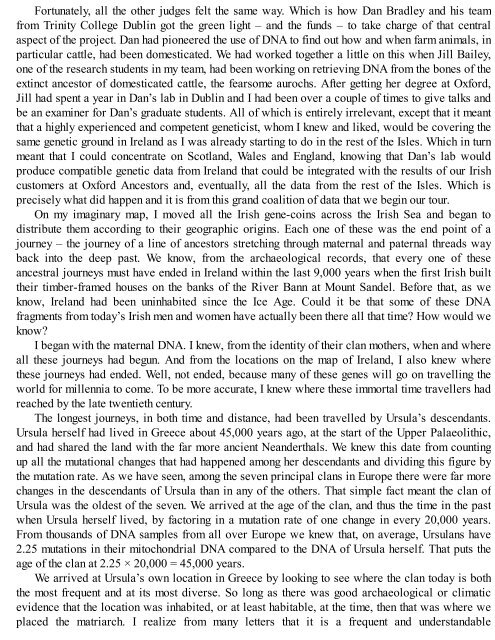Create successful ePaper yourself
Turn your PDF publications into a flip-book with our unique Google optimized e-Paper software.
Fortunately, all the other judges felt the same way. Which is how Dan Bradley and his team<br />
from Trinity College Dublin got the green light – and the funds – to take charge of that central<br />
aspect of the project. Dan had pioneered the use of DNA to find out how and when farm animals, in<br />
particular cattle, had been domesticated. We had worked together a little on this when Jill Bailey,<br />
one of the research students in my team, had been working on retrieving DNA from the bones of the<br />
extinct ancestor of domesticated cattle, the fearsome aurochs. After getting her degree at Oxford,<br />
Jill had spent a year in Dan’s lab in Dublin and I had been over a couple of times to give talks and<br />
be an examiner for Dan’s graduate students. All of which is entirely irrelevant, except that it meant<br />
that a highly experienced and competent geneticist, whom I knew and liked, would be covering the<br />
same genetic ground in Ireland as I was already starting to do in the rest of the Isles. Which in turn<br />
meant that I could concentrate on Scotland, Wales and England, knowing that Dan’s lab would<br />
produce compatible genetic data from Ireland that could be integrated with the results of our Irish<br />
customers at Oxford Ancestors and, eventually, all the data from the rest of the Isles. Which is<br />
precisely what did happen and it is from this grand coalition of data that we begin our tour.<br />
On my imaginary map, I moved all the Irish gene-coins across the Irish Sea and began to<br />
distribute them according to their geographic origins. Each one of these was the end point of a<br />
journey – the journey of a line of ancestors stretching through maternal and paternal threads way<br />
back into the deep past. We know, from the archaeological records, that every one of these<br />
ancestral journeys must have ended in Ireland within the last 9,000 years when the first Irish built<br />
their timber-framed houses on the banks of the River Bann at Mount Sandel. Before that, as we<br />
know, Ireland had been uninhabited since the Ice Age. Could it be that some of these DNA<br />
fragments from today’s Irish men and women have actually been there all that time? How would we<br />
know?<br />
I began with the maternal DNA. I knew, from the identity of their clan mothers, when and where<br />
all these journeys had begun. And from the locations on the map of Ireland, I also knew where<br />
these journeys had ended. Well, not ended, because many of these genes will go on travelling the<br />
world for millennia to come. To be more accurate, I knew where these immortal time travellers had<br />
reached by the late twentieth century.<br />
The longest journeys, in both time and distance, had been travelled by Ursula’s descendants.<br />
Ursula herself had lived in Greece about 45,000 years ago, at the start of the Upper Palaeolithic,<br />
and had shared the land with the far more ancient Neanderthals. We knew this date from counting<br />
up all the mutational changes that had happened among her descendants and dividing this figure by<br />
the mutation rate. As we have seen, among the seven principal clans in Europe there were far more<br />
changes in the descendants of Ursula than in any of the others. That simple fact meant the clan of<br />
Ursula was the oldest of the seven. We arrived at the age of the clan, and thus the time in the past<br />
when Ursula herself lived, by factoring in a mutation rate of one change in every 20,000 years.<br />
From thousands of DNA samples from all over Europe we knew that, on average, Ursulans have<br />
2.25 mutations in their mitochondrial DNA compared to the DNA of Ursula herself. That puts the<br />
age of the clan at 2.25 × 20,000 = 45,000 years.<br />
We arrived at Ursula’s own location in Greece by looking to see where the clan today is both<br />
the most frequent and at its most diverse. So long as there was good archaeological or climatic<br />
evidence that the location was inhabited, or at least habitable, at the time, then that was where we<br />
placed the matriarch. I realize from many letters that it is a frequent and understandable
















